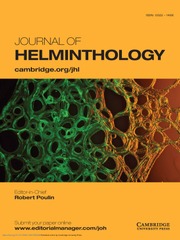No CrossRef data available.
Article contents
Characterisation and serodiagnostic evaluation of a recombinant 22.6-kDa tegument protein of Schistosoma spindale
Published online by Cambridge University Press: 10 December 2024
Abstract
Schistosomosis in animals due to Schistosoma spindale significantly burdens India’s livestock economy because of high prevalence and morbidity and is mostly underdiagnosed from the lack of sensitive tools for field-level detection. This study aimed to clone, express the 22.6-kDa tegument protein of S. spindale (rSs22.6kDa) and to utilise it in a dot enzyme-linked immunosorbent assay for serodiagnosis. RNA was extracted from adult worms recovered from the mesenteries of slaughtered cattle to amplify the gene encoding the 22.6-kDa protein. In silico analysis revealed the protein’s secondary structure, consisting of 190 amino acids forming alpha helices (47.89%), extended strands (17.37%), beta turns (8.95%), and random coils (25.79%), with α helices and β sheets in the tertiary structure. Two conserved domains were noted: an EF-hand domain at the N-terminus and a dynein light-chain domain at the C-terminus. Phylogenetic studies positioned the S. spindale sequence as a sister clade to Schistosoma haematobium and Schistosoma bovis. The gene was cloned into a pJET vector and transformed into Escherichia coli Top 10 cells, with expression achieved using a pET28b vector, BL21 E. coli cells, and induction with 0.6 mM isopropyl-β-d-thiogalactopyranoside. The protein’s soluble fraction was purified using nickel-chelating affinity chromatography, confirmed by sodium dodecyl sulfate–polyacrylamide gel electrophoresis and immunoblotting, identifying a distinct immunodominant 22.6-kDa protein. The diagnostic utility was validated using a dot enzyme-linked immunosorbent assay which demonstrated a of sensitivity of 89.47% and specificity of 100%. The study records for the first time the prokaryotic expression and evaluation of the 22.6-kDa tegumental protein of S. spindale, highlighting its potential as a diagnostic antigen for seroprevalence studies in bovine intestinal schistosomosis.
Keywords
- Type
- Research Paper
- Information
- Copyright
- © The Author(s), 2024. Published by Cambridge University Press


